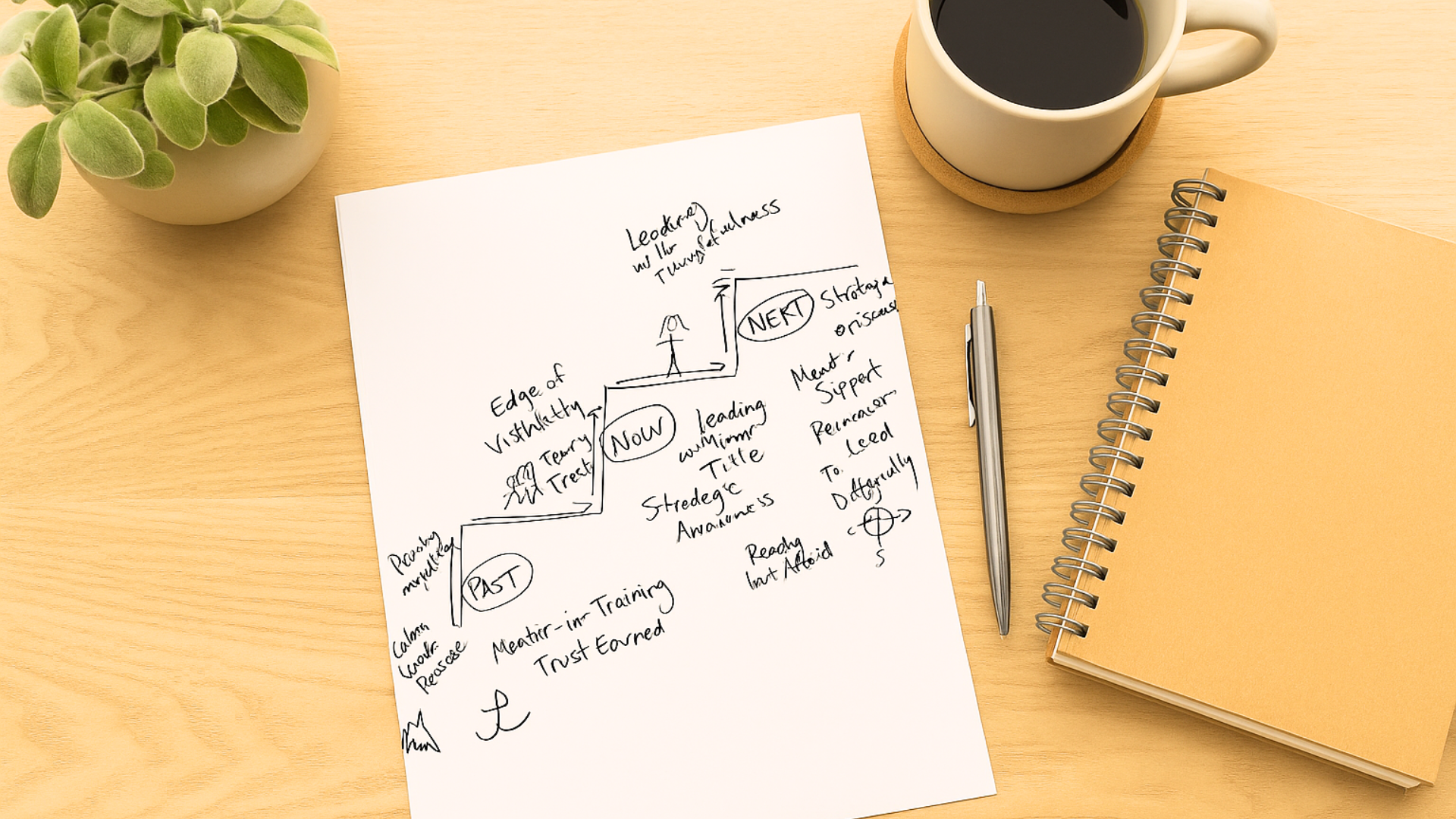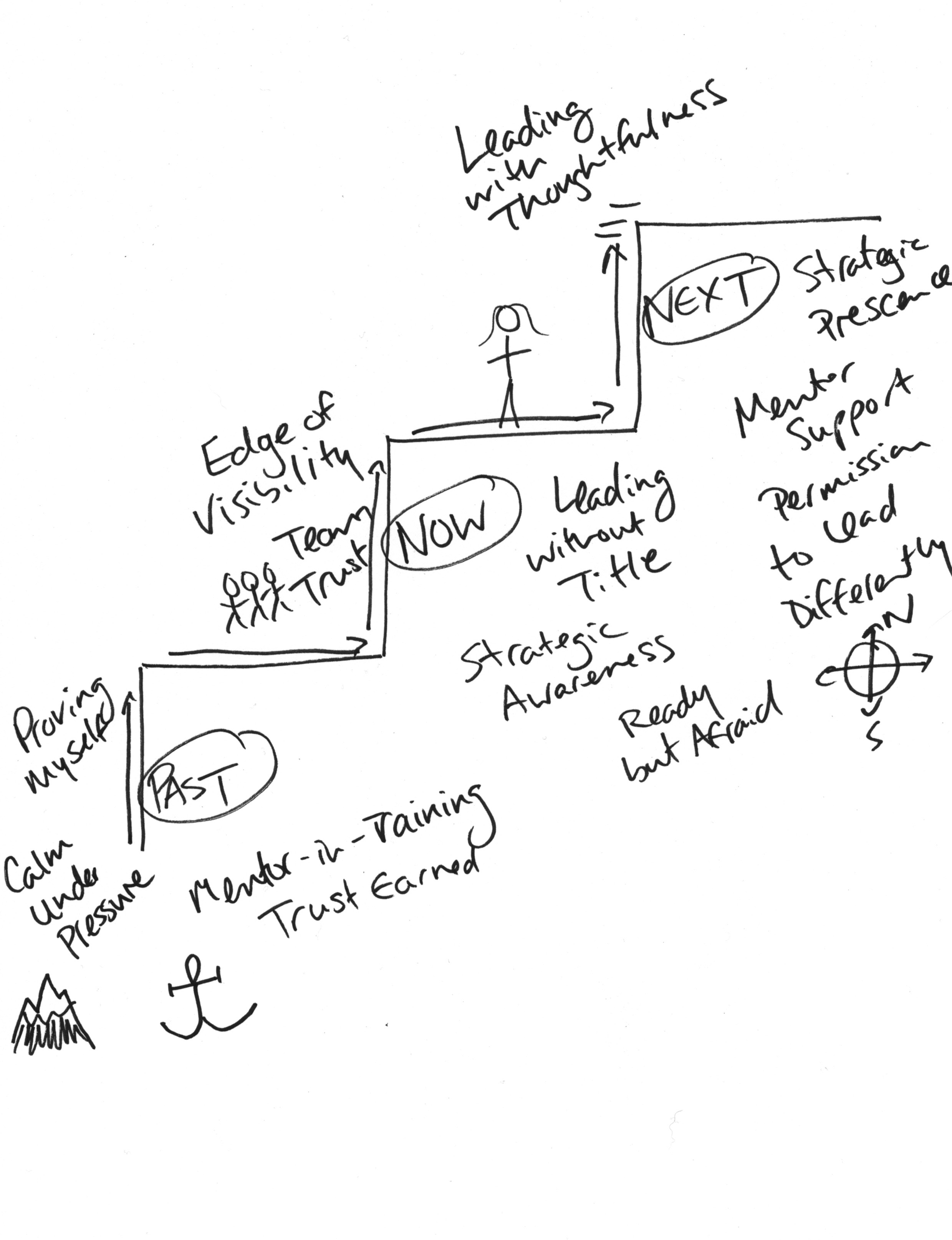Drawing Clarity: How One Quiet Leader Found Her Next Step Through Coaching

You know that feeling when something that should be a win just makes you pause?
That’s where Elena found herself.
She’s a data scientist who’s been leading quietly for years. She builds solid models, delivers under pressure, mentors junior staff, and shows up when things get tough. So when the executive team offered her a department leadership role, it seemed like the obvious next move.
But instead of excitement, she felt hesitation.
“I’m not sure I’m ready. What if I lose what I love about my work?”
I hear this a lot in coaching, especially from women in STEM. There comes a point when your current role starts to feel too small, but the next one feels a bit unclear. The path forward looks fuzzy. Maybe even risky.
Elena wasn’t doubting herself. She was wondering what this change might cost her—and whether it actually fit the kind of leader she wanted to be.
To help her sort through those thoughts, I used one of my favourite tools. It’s a simple drawing exercise called The Next Step.
Why Drawing Helps When You’re Stuck
When your mind feels like a knot, putting things on paper can help you untangle it.
Drawing doesn’t need to be beautiful or polished. It just gives your ideas a place to land. Emotions that once felt overwhelming start to take shape. And instead of imagining a huge leap, you begin to notice thoughtful, manageable steps.
Elena drew three steps:
- The bottom one was her past
- The middle represented where she is now
- The top held the possibility she was trying to understand
Here’s what she saw.

Step One: Looking Back with Clarity
The first step was about naming where she’d already been.
She labelled it “Deep Work and Proving Myself.” It captured the years she’d spent becoming someone her team could rely on. Someone who stayed calm in high-stakes moments. Someone who didn’t chase credit but helped others succeed.
She added words to the step: mentor-in-training, resilient, steady.
Then she stopped.
She realized those weren’t beginner qualities. They were signs of someone who’d already been leading. She just hadn’t seen it that way.
Step Two: Naming the In-Between
The middle step was her current role: technical lead. A bit more visible, with more responsibility. A little less coding, a little more guiding.
She called it “The Edge of Visibility.”
That phrase stayed with me.
She still did hands-on work, but others were starting to look to her for direction. That shift felt exciting and a little scary.
“People are listening to me now,” she said. “That’s new. It feels good… but also kind of exposed.”
She realized she wasn’t starting from zero. She was already near the top of that step. Already stepping into leadership.
Step Three: Exploring the Possibility
The final step was the leadership role she’d been offered.
She named it “Leading with Thoughtfulness.”
It wasn’t about managing people just for the sake of it. It was about shaping culture. Mentoring others at scale. Creating space for work that really mattered.
But she was honest. “I don’t want to become someone I don’t recognize. Always rushing. Disconnected. Burned out.”
We drew that out too. What would it look like to lead in a way that felt grounded? She added words like clarity, mentorship, and aligned decisions.
The unknown started to feel less overwhelming. Still big—but no longer blurry.
The Moment It All Shifted
Near the end of our session, I asked her:
“How will you know when you’re ready?”
She sat with it for a minute. Then said quietly, “I think I’ll know when I stop needing to prove myself every second. When I trust that my presence is enough.”
She wrote that beside the top step.
That was it. The shift.
This wasn’t about becoming more ready. It was about seeing that she already was.
Why This Kind of Reflection Matters
In fast-moving STEM fields, growth often gets measured in titles and deadlines. But internal growth doesn’t always follow that pattern.
Sometimes growth means slowing down long enough to see what you’ve learned.
Sometimes it means naming your values before you make the next move.
Sometimes it’s as simple as drawing three steps and realising how far you’ve already come.
The Next Step doesn’t give you an answer. It gives your thoughts a place to settle. And that can make the next move feel a lot less overwhelming.
Why I Use Drawing in Coaching
Drawing isn’t about being artistic. It’s about giving your thoughts some breathing room.
When we’re under pressure, everything gets trapped in our head. Sketching things out slows that down. It helps you pause, reflect, and make decisions from a place that feels honest.
Here’s what visual coaching tools can offer:
- A break from the mental spiral
- A way to hold uncertainty with structure
- A gentler way to talk through big feelings
- A more embodied and memorable reflection
It’s not about getting it right. It’s about letting yourself see what’s already there.
Your Turn
If you’re standing in front of a big decision, you don’t need to figure everything out right now.
Just draw three steps.
Where have you been?
Where are you now?
What could be waiting for you next?
Even just naming those can shift something inside.
And if you’d like support while you sort things through, there are a couple of ways we can stay connected.
You can book a free Clarity Call to talk through what’s coming up and see whether coaching might be a good fit. It’s a quiet, no-pressure conversation to help you reflect and reconnect. Schedule your Clarity Call here.
Or you can join the 5-Day Creative Reset Challenge to try tools like this one for yourself.
Because sometimes, your next step doesn’t begin with a plan. It begins with a pen and a little space to breathe.